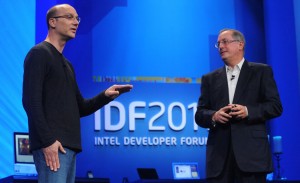Intel kicked off its Intel Developers Forum in San Francisco Tuesday showing off an Ultrabook with iPhone Siri-like functions, new gesture controls for PCs, and its newest Haswell Core processor aimed at the mobile PC market.
Intel Chief Product Officer David (Dadi) Perlmutter lead the keynote and shared his vision for a connected future–powered by Intel, of course.
Perlmutter wasted little time and outlined how Intel was “redefining the computing experience” officially announcing its Haswell processor. The chip is the most power efficient processor Intel has built, Perlmutter said, and will allow thinner lighter notebooks with touchscreens, all-day battery life, and instant on functionality. He claimed the chip is 20 times more power efficient compared to its earlier Sandy Bridge notebook chip while at the same time increasing graphics performance two fold.
Intel’s roadmap to “reinventing mobility”, as Perlmutter put it, also includes speech, touch, and gesture interfaces for Ultrabooks, PCs, and a bevy of mobile devices. Perlmutter said Intel is working on delivering a “true interactive experience across all devices.” The goal is to give computers human-like senses, he said.
Gesture-friendly PCs
Perlmutter then demonstrated speech recognition software maker Nuance’s Dragon Assistant software running on a Dell Ultrabook. The demo was similar to Apple’s voice assistance technology Siri. Perlmutter said Ultrabooks equipped with Dragon Assistant Beta will be available later this year.
Perlmutter also showed off hand gesture control of games and applications running on a PC equipped with a small Creative Technology camera and software developed by SoftKinectic, a company that makes gesture recognition applications.
Perlmutter said Intel would be releasing a software developers kit that would help PC and device makers incorporate speech, facial recognition, and hand gestures. To help spur innovation, Intel is doling out $1 million in awards to developers who come up with the best ideas for its SDK.
Atom vs. ARM
Under a backdrop of sluggish PC sales and a rise of tablets and smartphones, Perlmutter also talked about Intel’s “Medfield SoCo” Atom processor used in smartphones and tablets. Intel is noticeably absent from that market. As desktop and notebook sales slump, Intel is pinning its hopes on Medfield. Perlmutter says its mobile chip will be an alternative to the competing ARM architecture processors found in devices such as the iPhone, iPad, and most Android smartphones and tablets.
On stage, Perlmutter showed off a number of Atom-based tablets and claimed several “design wins” based on its Clover Trail Atom-based platform.
Intel in the Cloud
On the power front, Perlmutter discussed Intel’s Xeon Phi coprocessor used for high performance computing. The digitisation of data coupled with the boom of social media has created a goldmine for Intel processors to be the brains and brawn behind number crunching and data centres.
While Intel may not dominate the chips running inside smartphones and tablets, it does dominate the cloud those devices connect to. Intel likes to point out that most of the high-end servers that power the Internet run the company’s high-end chips, such as Xeon Phi coprocessors.
Perlmutter closed his keynote with the oddest demo of the day–a Coke machine with en embedded Intel Core i7 CPU. The vending machine had a large multitouch screen, integrated camera, and Wi-Fi. It’s both a demo and Intel’s attempt at illustrating the ubiquity of the Intel chip architecture and how much PC technology has become a commodity.






